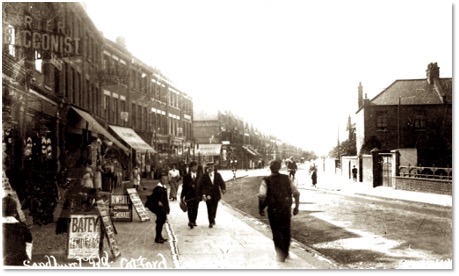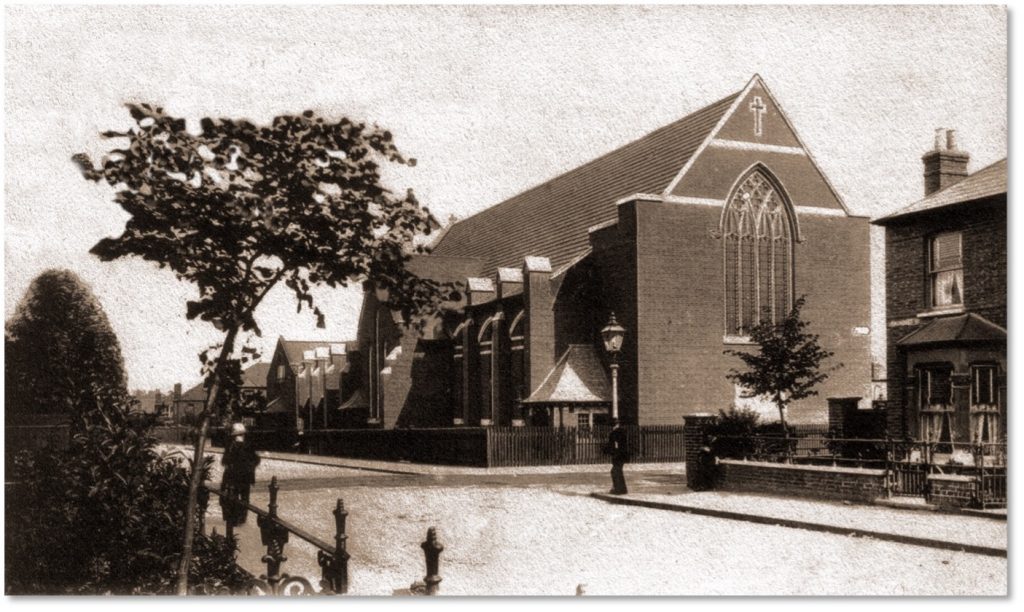“The Most Populous Street”

A view along Sandhurst Parade towards Sangley Road
Background
Sandhurst Road is a bit of an anomaly, in that we can’t find a Scottish reference to such a name. That’s unusual given that Corbett was keen to name-check so many of the places he knew from his childhood north of the border. If you can find a connection, we’d love to hear about it!
The Early Residents: details from the 1911 Census
On the day of the Census in April 1911, Sandhurst Road had 1,114 residents (plus 8 visitors), which made it the most populous on the whole estate. Interestingly however, it didn’t have the most houses: in fact it wasn’t even second on that list. With 179, it actually came in 4th (Ardgowan, with 229 house was in first place), and when you put those two facts together, it’s perhaps not surprising that Sandhurst had the highest average population density. An average of 6.2 people lived in each house, compared to the estate-wide figure of 4.4 people (and just 3.8 in nearby Birkhall where the houses are actually larger).
Sandhurst takes the Estate’s second prize for the most number of people living in a single house (first prize goes to the 14 people sharing the rooms above the shop at No. 261 Brownhill Road). If you’d knocked on the door of No. 103 back then it would probably have been answered by a harassed-looking woman called Jane, who lived with her stonemason husband Alfred (both age 36). Jane and Alfred had 4 daughters and 5 sons in their 3-bedroom house (with a downstairs toilet). The daughters were Jane (13), Victoria (11), Frances (6) and Ivy (4); and the sons were Alfred (10), George (8), William (7), Frederick (2) and John (0). For good measure, they also shared the house with Jane’s brother William (39) and HIS daughter Annie (9)! That’s 13 people in total.

The junction of Sandhurst Road and Torridon Road, with the newly built St Andrews Church
The road also stands out because, in contrast with most of the other streets, the most common job wasn’t ‘Clerk’, but ‘Domestic Servant’. Possibly quite a few of the 34 servants listed in 1911 worked in larger houses on the same estate. In terms of employing their own live-in servant, only 3 of the 179 houses had one, in sharp contrast to 41 houses out of 66 on Brownhill Road.
Sandhurst would have been seen as very much a ‘working class’ street, but many of the inhabitants might well have been defined as ‘artisans’ – skilled craftsmen and women who made things with their hands, as opposed to labourers who did the heavy manual work. There certainly were labourers living there too, but I doubt that’s how Alfred Povey, the stonemason, would have classified himself.
A final couple of ‘first place’ prizes go to Sandhurst for having the most number of houses with lodgers (a common way to supplement your income or care for extended family); and the highest ratio of residents born within London: 82% against the estate average of 72%.
HISTORICAL CONTEXT: Overcrowding
The 13 people living at No. 103 Sandhurst Road can’t have had an easy time of it, and by the standards of the Estate, the house was certainly crowded. But was it unusual for London at the time? According to one overall analysis of the Census:
“the average number of persons to an inhabited building was 5.05 in 1911, against 5.20 in 1901; in all urban districts (including London and the County Boroughs) the averages were 5.23 and 5.40 respectively, while in the rural districts they were 4.51 and 4.58” (visionofbritain.org)
So, whilst the Estate as a whole had a lower than average 4.4 people per house, the Poveys bucked that trend and had more than double the London average. Could you say that their house was overcrowded? The census definition for overcrowding was more than two people per room, with children under ten counting as half a person, so with 5 rooms (3 bedrooms and 2 main rooms downstairs) the house wouldn’t actually have counted as officially overcrowded!
Conditions in London had improved massively over the previous half-century. In the 1850s the city had started to rapidly expand, and housing the rapidly growing population was a huge problem:
‘Hideous slums, some of them acres wide, some no more than crannies of obscure misery, make up a substantial part of the, metropolis … In big, once handsome houses, thirty or more people of all ages may inhabit a single room’ (The Victorian underworld, 1970)
Archibald Corbett was well acquainted with the problems of slum living in his native Glasgow, and was keen to give people far better living conditions.